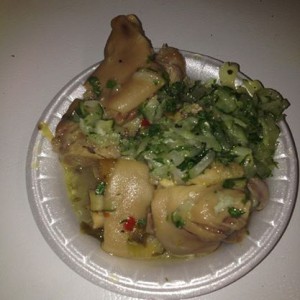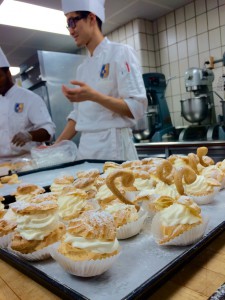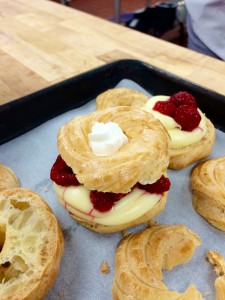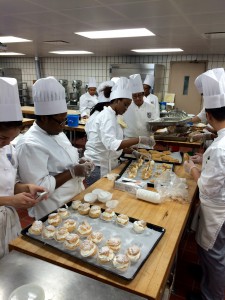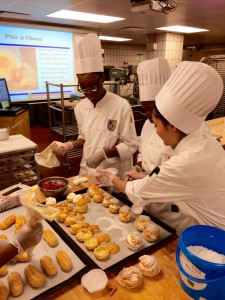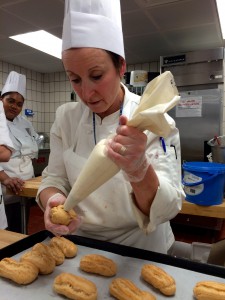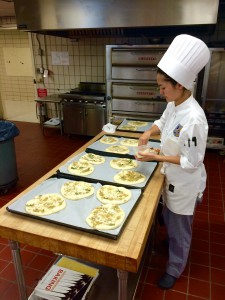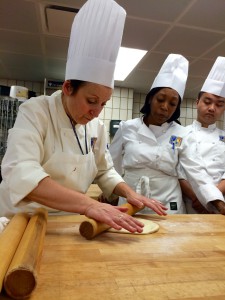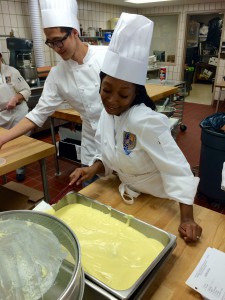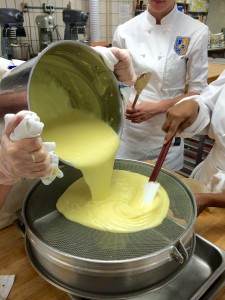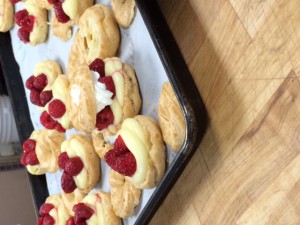The other day my boyfriend said something that stood out to me, he said “the best place to get delicious are from “hole in a wall” places.” I immediately thought of all the places in Flushing, Queens I’ve been to that aren’t chain restaurants or upscale restaurants that serves good, authentic cuisine. The picture above is Hong Kong style steamed rice noodle drizzle with hoisin and peanut butter sauce garnish with sesame seeds from the food court at a Flushing mall. The dish looks delicious because the color of the two sauces coated evenly on the rice noodle. It is also a comfort food which in my opinion makes it even more delicious.
Announcement: Blogging Guidelines, Midterm Grades, and Extra Credit Options
 Thanks to all who have been blogging regularly and since we’re going into the last half of the semester I’ve decided to make a change to the submission process for our Discussion Topics. As of this week (Week 8), you will have a long deadline due date and be able to submit your posts up until Monday December 14 (our last lecture meeting before Finals). However, at this point in the semester please do not submit posts for earlier Discussion Topics (Weeks 1-7) because you will not receive credit for them.
Thanks to all who have been blogging regularly and since we’re going into the last half of the semester I’ve decided to make a change to the submission process for our Discussion Topics. As of this week (Week 8), you will have a long deadline due date and be able to submit your posts up until Monday December 14 (our last lecture meeting before Finals). However, at this point in the semester please do not submit posts for earlier Discussion Topics (Weeks 1-7) because you will not receive credit for them.
By now you may have noticed that your mid-semester grades are posted. If you have any questions, please email me at scheng@citytech.cuny.edu. Please keep checking the grade center on Blackboard for updates on the grades for your papers, all paper grades will be up by the end of the week.
Because of financial aid considerations, withdrawing from a class is not recommended. However, if you are contemplating withdrawing, please be advised that the last day to withdraw without penalty is Thursday, Nov. 6. This is the last day to withdraw with a W grade.
A reminder, mid-semester grades are:
P=Passing work
*BL= Borderline
U=Unsatisfactory
SA=Stopped Attending
*If you received a BL, it is likely that you are having problems with your attendance, didn’t do so well on the midterm, or missing the paper assignment and have done no blogging.. Having said that, it is in your best interest to participate fully on the class blog because it is worth 15% of your grade. What is 15%? It’s worth more than one letter grade on the grade scale, meaning if you’re averaging a C in the course, weekly participation on the discussion board can pull you up into the B/B+ range. Therefore, please participate and use the blogging to your advantage.
I have also posted the Extra Credit Assignments. There are 6 options and they are optional, you can submit one extra credit, do all the options or do none, it is up to you. You will find the extra credit under assignments.
The discussion board for Week 8 is: https://openlab.citytech.cuny.edu/fylcartoffoodfall2014/2014/11/02/week-8-discussion-topic-photography-and-special-effects-in-early-film/
Extra Credit assignments: https://openlab.citytech.cuny.edu/fylcartoffoodfall2014/assignments/extra-credit-options/
Week 8 Discussion Topic: Photography and Special Effects in Early Film
Georges Méliès released the first science fiction film A Trip to the Moon (Le voyage dans la lune) in 1902. The filmmaker spared no expense for special effects and is regarded as the “father of special effects.” Some of you may have seen Martin Scorsese’s Hugo (2011), which features Méliès, who really went bankrupt in old age and eked out a living selling candy and toys in the Montparnasse station in Paris. Review his short film and consider the following questions. Do any aspects of the film recall the practices of early photography? What are some differences and similarities between the photographic camera and the film camera?
There are many copies on the web of various degrees of quality (you can even find copies of a recently restored hand-colored version). The quality of the following version on YouTube is very good.
Georges Méliès’ A Trip to the Moon
If you are interested, you can watch a clip from Scorsese’s Hugo here. The music video for Tonight, Tonight by the Smashing Pumpkins is an homage to Méliès, watch it here.
Please submit your posts by Monday, December 15th.
why does it look delish?
I think this tres leches look delish because of its shiny color and because the tres leches cake melts in my mouth as I try it, sticky with fudge frosting on my tongue. The bitter and simultaneously sweet smell of it puts me in a serene mind state. With the rich deep shades of the frosting on top of delicious layers of condensed milk. this cake acts as a slice of happiness on a white styrofoam plate. the beautiful frosting tastes as great as it looks.
This is delish
This is and egg benedict with omelet. The sweetness and sourness of the hollandaise sauce makes the egg benedict very delicious. This was my first time having eggs benedict and was simple delicious the poached eggs where soft and tender, the crispness of the muffin was just undeniably tasty i could not get over the taste so much that when i got home i made one and the following morning i made another one and it was so good. I introduced my family to it and they all loved it without a doubt. I have always have my eggs really cooked when boiled or fried, so when i first had the omelet i was surprised how much i liked it. The softness of the omelet and the way it melted in my mouth made all the differences, i always liked my eggs well made and ever since i tasted that omelet i have always made my eggs very tender and soft
Leah M. Why does it look delish?
On the last Sunday in October, the french speaking islands in the Caribbean celebrate international creole day. Being away from home, my family celebrates this day just as we would if we were back in St.Lucia. We prepared food that you would find at the creole festival. Food items such as Pig foot souse, stewed local fowl, lambi (conch) stew pork, black pudding (blood sausage), penny piece, smoke herrings, green fig and salt fish which is the national dish of St.Lucia by the way and lots more. I chose this particular dish prepared by me so my family could enjoy which they did. The dish featured is pig foot souse with a cool cucumber salad. The sourness from the limes squeezed in the cucumber salad and the crushed garlic and salt brought out more flavor in the pig foot. Also in the pig foot souse which is salted overnight, washed the following morning, seasoned and boiled for an extended period of time. Lemon or lime juice is also included in the pig foot. You will not regret trying it. You may just love it. You can enjoy this dish with local bread, baked in outdoor ovens and local drinks such as passion fruit, golden apple, tamarind and my favorite lime squash just to name a few.
Pig foot souse prepared by Leah M.
Week 8 (Baking and Pastry Arts 1 Prof. Jacus)
Documenting Spiritualism
In my opinion, for spiritualism to be documented effectively, a very abstract component must be lured out of one’s viewer–faith. A viewer doesn’t have to share the photographer’s religious denomination to appreciate the work; a viewer only has to have a smidgen of understanding, that openness of the mind. Without it, the viewer would not ‘see’ anything at all, no matter how skillful the photographer is or how convincing the image turned out to be.
For me, personally, I believe that spiritual documentation is possible. Although not a very religious person myself, I simply think that anything is possible in this world. In this case, however, a photographer must be fully immersed into the subject: He or she has to believe it. For it being valuable, sure, for any type of evidence towards its accreditation (or otherwise) must be kept and accounted for. It’s like graffiti, once rejected for its impetuous and rebellious nature, but is now considered an art form; spiritual documentation can be the same: it might not receive a great deal of following right now, but people would eventually see how its uniqueness can be translated to creativeness. And then, again, one doesn’t have to believe in its validity for it to be considered beautiful.
Intrusive? Yes, for the camera being present is like a perpetual intruder. I feel that it undermines the sanctity of the supernatural, and with popularity of image editors out there, a non-believer could easily discredit a photograph by referring to these software. Ultimately, manifestations must be experienced to be called true. A photograph is merely a medium to speak of its existence, and it is only up to the viewer to believe it or not.
Why so delish?
The photo that you see above is an once ordinary cream puff that we transformed by adding multiple ingredients made in Professor Jacus Baking 1 class. We stuffed the bottom of the cream puff with vanilla pastry cream then topped it with frozen raspberries and finished it off with cream Chantilly. In several of the raspberry cream puffs you can see the juices from the raspberries itself flowing alongside the vanilla cream suggesting that the raspberries are full of sweetness. The brightness of the fruit can also suggest that the fruits are crisp. The flakiness of the cream puff allows for a slight crunch factor in the desert. You can see that the texture of the Chantilly is light and delicate the way it peeks through the top hole of the cream puff top.
Subway Portraits
Although I am not completely acquainted with the most popular approaches on photography back in Evans’ time, I feel that his technique makes the subjects look truly unaffected and real. You can see this through the effortlessness of the shots–subjects looking wary or being unfocused or even not looking at all. Others have no idea that they are being photographed, thus simply doing what they normally do, from reading the newspaper to snoozing or biting one’s lip in deep thought. I really find this fascinating (the ability to capture a subject’s inner unfiltered emotions), because I believe that capturing such moments take a certain dexterity and timing that cannot be replicated all over and over again. For some reason, it reminds me of Southworth and Hawes, as they are famous for drawing out the personalities of their subjects. However, in contrast to them, Evans was able to do such an undertaking without the fluff of props and, rather, by just taking in whatever is available at the moment. As for similarities to today’s riders, I would say that there would be instances when riders would also exude the same facial reactions as Evans’ subjects. For example, if taken at the right moment, without the camera being seen, such artlessness can be captured from today’s riders. Unfortunately, today’s riders are very acquainted with the camera (and it’s various forms), so some photos might feature subjects deliberately posing or altering their reactions.


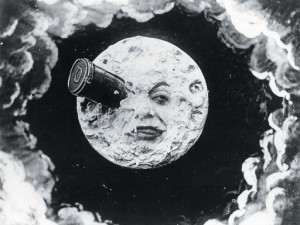
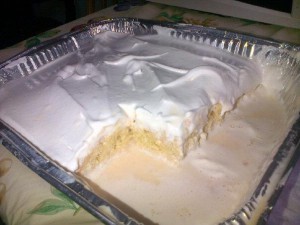
![IMG_1588[1]](https://openlab.citytech.cuny.edu/fylcartoffoodfall2014/files/2014/11/IMG_15881-e1414973074316-225x300.jpg)
